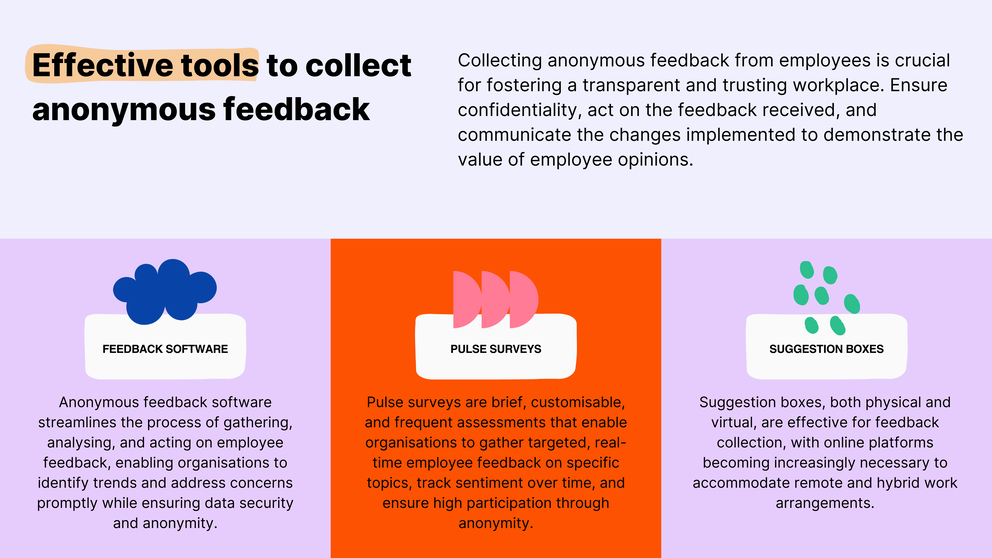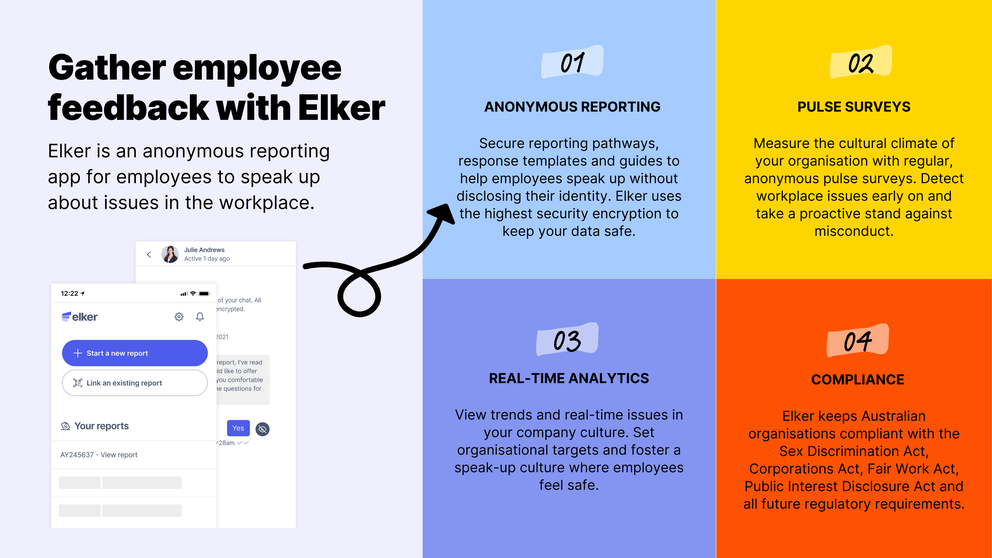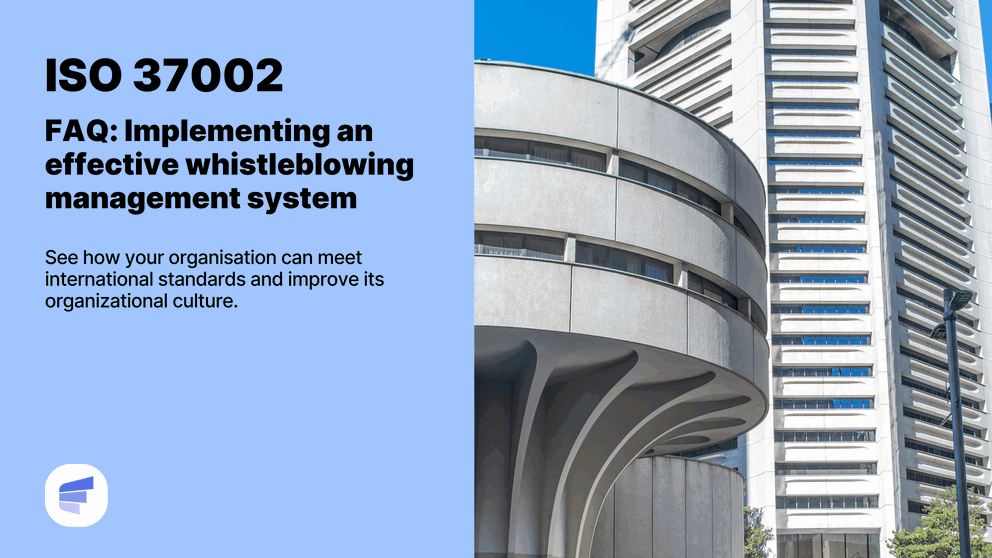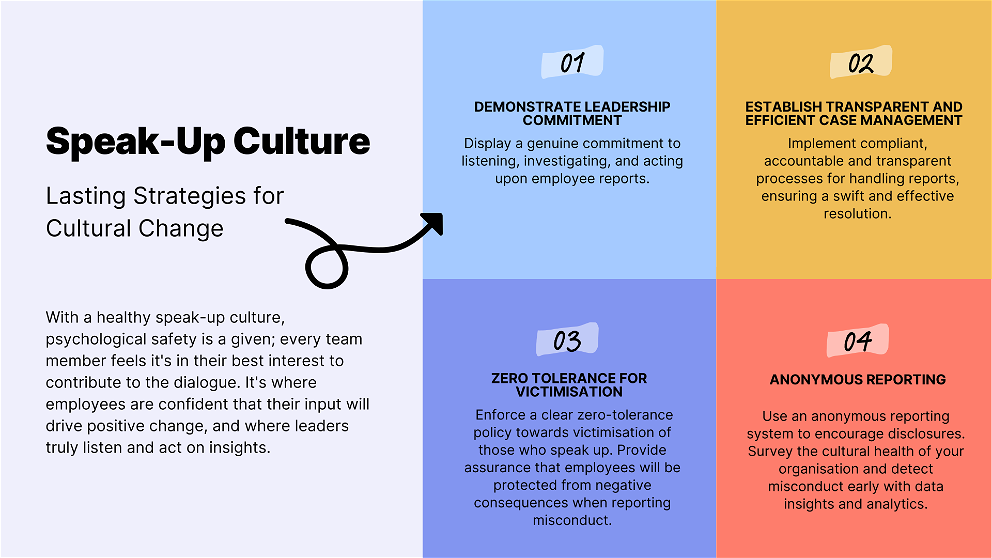How to collect anonymous employee feedback

We've all heard the saying "honesty is the best policy," but let's face it – being honest at work can be intimidating. You don't want to rock the boat or risk damaging your relationships with your colleagues.
The truth is, without honest feedback, it's tough for any organisation to identify areas for improvement and create a safer, more inclusive workplace.
That's why anonymous feedback is so powerful.
What is anonymous employee feedback?
Anonymous employee feedback is a method of collecting honest opinions, suggestions, and concerns from employees without requiring them to reveal their identity. This type of feedback allows employees to express themselves freely without fear of repercussions or judgment from their managers or colleagues.
Anonymous feedback can be gathered through various means, such as online surveys, feedback software, or a suggestion box. Anonymity encourages employees to provide candid feedback that can help organisations identify areas for improvement, make data-driven decisions, and foster a more open and transparent work environment.
By allowing employees a safe space to share their thoughts, anonymous feedback can lead to valuable insights and drive positive change within an organisation.
How to collect anonymous employee feedback
There are several effective methods for gathering anonymous feedback, each with its own advantages and considerations.
We'll explore three of the most popular and efficient approaches: feedback software, pulse surveys, and suggestion boxes.
Anonymous employee feedback software
Feedback software is a solid solution for gathering feedback, especially in larger organisations and business with hybrid and remote working arrangements. These platforms offer a streamlined, user-friendly approach to submit, analyse, and act on employee feedback and whistleblowing disclosures.
One of the key advantages of using anonymous feedback tools is the ability to collect and centralise feedback data in real-time. This allows HR teams and managers to quickly identify trends, patterns, and areas for improvement, enabling them to take swift action to address employee concerns.
Additionally, many anonymous feedback platforms offer built-in analytics and reporting features, making it easy to visualise and share insights with stakeholders.
The best anonymous feedback tools prioritise data security and anonymity, ensuring that employees feel comfortable voicing their concerns without fear of repercussions.
Some popular anonymous employee feedback tools include:
- Elker, which prioritises anonymity and security for sensitive disclosures, whistleblowing and specific compliance needs
- Culture Amp, an employee experience app that features performance management and feedback tools
- Suggestion Ox, a simple-to-use anonymous feedback tool for a broad range of uses to solicit feedback and concerns in the workplace.
Pulse surveys
Pulse surveys are short, frequent surveys designed to gather targeted, real-time feedback from employees on specific topics or issues. They are typically administered on a weekly, bi-weekly, or monthly basis, allowing organisations to audit employee sentiment and engagement over time.
One of the primary benefits of pulse surveys is their flexibility and customisation. Organisations can tailor survey questions to address specific concerns, such as workplace culture, management effectiveness, or employee well-being.
To ensure high participation rates and honest feedback with your anonymous feedback survey, it's essential to keep surveys brief, focused, and anonymous. Aim for surveys that take no more than 5-10 minutes to complete, and limit the number of questions to 10 or fewer.
Some popular pulse survey tools include:
- TinyPulse, an employee engagement and survey tool with an option for anonymity
- Culture Monkey, a more complete engagement platform featuring a pulse survey tool for continuous anonymous feedback
- Elker, offering pulse surveys and an employee feedback tool for critical disclosures and employee insights
Suggestion boxes
Suggestion boxes remain a simple yet effective method to collect feedback in the workplace. They offer a low-tech, accessible option for employees who may be less comfortable with online platforms or prefer a more traditional approach. However, with the rise of remote and hybrid employment arrangements, for many organisations having an online tool is necessary.
A virtual suggestion box can take the form of a dedicated email address or an online form where employees can provide feedback and make disclosures.
Some examples include:
- Google forms
- Microsoft forms
- Secure email address
While all of these tools can collect feedback, there are limits to the anonymity that these provide. Additional measures, such as using a VPN or a throwaway email address are necessary for users who want to preserve their anonymity.

Benefits of anonymous employee feedback
Implementing an anonymous employee feedback system can bring numerous benefits to an organisation, fostering a culture of transparency, trust, and continuous improvement.
By providing employees with a safe and confidential channel to share their thoughts, ideas, and concerns, organisations can access a wealth of valuable insights that might otherwise go unheard. In this section, we'll explore the key benefits of implementing anonymous employee feedback.
Eliminate victimisation
Many employees hesitate to provide feedback or raise concerns due to fear victimisation from their managers or colleagues. This fear can stem from various factors, such as power dynamics, personal relationships, or a history of negative experiences with speaking up.
Anonymity is particularly important for addressing topics such as sexual harassment, discrimination, or serious misconduct in the workplace.
By eliminating the fear of reprisal or judgment, anonymous feedback empowers employees to voice their concerns and contribute to creating a safer, more inclusive work environment.
Foster honesty and transparency
When employees feel that they can express their opinions without fear of repercussions, they are more likely to provide candid and constructive feedback. Honesty is essential for uncovering genuine issues, concerns, and opportunities for improvement that might not surface through traditional feedback channels.
Anonymous feedback creates a psychologically safe environment where employees can share their thoughts without worrying about judgment or negative consequences. This openness leads to more accurate and actionable insights, enabling organisations to make informed decisions and drive meaningful change.
Identify issues and opportunities for improvement early
When employees feel comfortable sharing their experiences and observations candidly, they can provide valuable insights into operational inefficiencies, communication breakdowns, or other challenges that might not be apparent to leadership.
By analysing feedback data, HR teams and managers can identify patterns and trends that point to systemic issues or areas for improvement. This information can be used to develop targeted action plans and initiatives to address these challenges head-on.
Building trust and improving employee satisfaction
Implementing an anonymous employee feedback system demonstrates an organisation's commitment to valuing and respecting the opinions of its workforce. When employees feel heard, they are more likely to feel valued and respected as individuals.
Levelling the playing field for all employees
By creating an equal opportunity for all employees to share their thoughts and experiences, anonymous feedback promotes a more inclusive and equitable workplace. This inclusivity is particularly important for underrepresented or marginalised groups who may feel less comfortable to speak up in open forums.
Compliance
In Australia, workplaces have a legal obligation to comply with the positive duty under the Sex Discrimination Act. This means that employers must take proactive steps to prevent and eliminate sexual harassment and discrimination in the workplace, rather than simply responding to incidents after they occur.
Implementing an anonymous employee feedback system, like Elker, can help you fulfil this positive duty and mitigate legal risks. By demonstrating that they have taken reasonable steps to prevent and address sexual harassment and discrimination, employers can protect workers and reduce their liability in the event of a claim or lawsuit.
For more information, contact Elker.
Implementing anonymous feedback: strategies and tools
Communicate the purpose and value of anonymous feedback
To encourage employees to provide anonymous feedback, it's crucial to clearly communicate the purpose and value of the feedback. Employees should understand that their opinions and suggestions are essential for driving positive change and improving the overall work environment.
Ensure anonymity and confidentiality
Employees must trust that their identities will be protected and that they won't face any negative consequences for providing honest feedback. Organisations should clearly communicate:
- whistleblower protection policies, so anonymous employee feedback does not lead to victimisation
- measures in place to maintain anonymity
- how to access and use the organisation's feedback software
By building trust in the anonymity of the process, organisations can create a safe space for employees to share their genuine opinions and concerns.
Make the feedback process easy and accessible
To maximise participation in anonymous employee feedback, organisations should strive to make the feedback process as easy and accessible as possible. This can involve using user-friendly feedback tools, such as online surveys, mobile apps, or dedicated feedback platforms that employees can access from any device.
The feedback process should be straightforward, with clear instructions and minimal time investment required. By removing barriers to participation and making the process convenient, organisations can encourage more employees to provide valuable insights.
Regularly remind employees to provide feedback
Consistent communication and reminders are essential for maintaining employee engagement in the anonymous feedback process.
Organisations should regularly encourage employees to provide feedback, highlighting the value of their input and the impact it can have on the workplace. This can be done through various channels, such as email reminders, team meetings, or company-wide announcements. By keeping anonymous feedback top-of-mind and making it a regular part of the company culture, organisations can foster a continuous cycle of feedback and improvement.
Share results and actions taken based on feedback
One of the most effective ways to encourage ongoing participation in anonymous employee feedback is by demonstrating that the feedback is being heard and acted upon.
Organisations should regularly share the results of feedback surveys, along with the specific actions being taken to address the issues and suggestions raised by employees. Transparency shows employees that their opinions matter and that the organisation is committed to making positive changes based on their input.
Addressing common concerns about anonymous feedback
Dealing with negative or unconstructive feedback
One common concern about anonymous employee feedback is the potential for receiving negative or unconstructive feedback. While it's true that anonymity may sometimes invite less constructive comments, it's essential to approach all feedback with an open mind and a focus on improvement. When dealing with negative feedback, organisations should look for underlying issues or trends that may be contributing to employee dissatisfaction.
By addressing these root causes, rather than dismissing the feedback as merely negative, organisations can demonstrate their commitment to creating a better work environment for all employees.
Verifying the authenticity of anonymous feedback
Another concern surrounding anonymous feedback is the potential for false or misleading information. To mitigate this risk, organisations can use various techniques to verify the authenticity of anonymous feedback. This may include cross-referencing feedback with other data sources, such as employee engagement surveys or performance metrics, to identify consistent patterns or themes.
Balancing anonymous and non-anonymous feedback
While anonymous feedback is valuable for gathering honest opinions and suggestions, it's important to recognise that it should not be the only form of employee feedback. Organisations should strive to create a feedback culture that balances anonymous and non-anonymous feedback channels. This can include regular one-on-one meetings, team discussions, and open forums where employees can share their thoughts and ideas directly with their managers and colleagues.
By fostering a mix of anonymous and non-anonymous feedback, organisations can benefit from each approach and create a more comprehensive picture of employee sentiment and engagement.
Integrating anonymous feedback into your company culture
Making anonymous feedback a regular practice
Organisations should integrate anonymous employee feedback into their company culture as a regular practice. This means going beyond occasional surveys and making anonymous feedback a consistent part of the employee experience. Organisations can achieve this by setting up recurring feedback cycles, such as quarterly or bi-annual surveys, and providing always-available channels for employees to submit feedback anonymously.
By normalising the practice of giving and receiving anonymous feedback, organisations can create a culture of continuous improvement and open communication.
Using insights from anonymous feedback for continuous improvement
Integrating anonymous feedback into company culture also involves using the insights gained from feedback to drive continuous improvement.
Organisations should establish processes for analysing feedback data, identifying key themes and priorities, and developing action plans to address the issues raised by employees. This may involve creating cross-functional teams or task forces to tackle specific challenges, setting measurable goals and timelines, and regularly communicating progress to employees.
By demonstrating a commitment to using anonymous feedback for continuous improvement, organisations can build trust and engagement among their workforce.
Celebrating successes and milestones achieved through anonymous feedback
Finally, to truly embed anonymous feedback into company culture, organisations should make a point of celebrating the successes and milestones achieved through the feedback process. This can include sharing stories of how anonymous feedback led to positive changes, recognising teams or individuals who contributed valuable insights, and highlighting the impact of feedback-driven initiatives on employee satisfaction and engagement.
By celebrating these successes, organisations can reinforce the value of anonymous feedback and encourage ongoing participation in the process. Over time, this positive reinforcement can help make anonymous feedback an integral part of the company's DNA, driving a culture of transparency, trust, and continuous improvement.

Gather feedback and transform your organisation's culture with Elker
Elker is a powerful anonymous feedback system that helps organisations identify and resolve workplace issues early on. Elker's secure reporting system allows employees to provide feedback about misconduct, unethical behavior, or other concerns without fear of retaliation.
One of the key advantages of using Elker is its emphasis on security and anonymity. The platform uses advanced encryption and data protection measures to ensure that employee identities are safeguarded throughout the reporting process.
Elker's reporting system is user-friendly and accessible, allowing employees to submit reports via web, phone, or mobile app. The platform also offers case management features, enabling HR teams and designated administrators to track, investigate, and resolve reported issues efficiently.
By leveraging Elker for anonymous employee feedback, organisations can foster a culture of transparency, trust, and early intervention. Ultimately, by embracing anonymous feedback through tools like Elker, organisations can drive continuous improvement and build a thriving workplace culture.
Book a demonstration today.
Frequently asked questions
Frequently asked questions about how to get feedback from employees and collecting anonymous employee feedback.
How often should we collect anonymous employee feedback?
The frequency of surveys and employee feedback depends on a number of factors, such as the size of your organisation, the nature of your business, and the goals you wish to achieve. Conducting quarterly or bi-annual anonymous surveys can help you track progress, identify trends, and address issues in promptly.
Alternatively, utilising an anonymous feedback platform, such as Elker, allows employees to share their thoughts whenever they feel the need.
What types of questions should we ask in anonymous surveys?
When collecting anonymous employee feedback, open-ended questions that allow employees to express their thoughts in their own words can provide rich qualitative data. For example, asking questions like "What are the biggest challenges you face in your role?" or "What suggestions do you have for improving our work processes?" can uncover specific issues and potential solutions.
For examples, visit our article on employee engagement survey questions.
Can we combine anonymous feedback with other employee engagement initiatives?
Yes, anonymous feedback should be combined with other employee engagement initiatives for a comprehensive approach to understanding and addressing employee needs.
Anonymous feedback can be used with regular performance reviews, pulse surveys, employee focus groups, or town hall meetings.
How can we measure the impact of anonymous feedback on our organisation?
To measure the impact of anonymous feedback:
- track key metrics such as participation rate, which indicates employee engagement and trust in the process
- monitor the number and type of issues identified and the percentage of those issues successfully addressed or resolved
- employee engagement scores, retention rates, and exit interviews can provide insight into the impact of anonymous feedback on overall employee satisfaction and turnover.
How do I set up anonymous feedback for employees?
To collect anonymous feedback from employees, start by choosing a method, such as online surveys, feedback software, or suggestion boxes. Ensure the chosen platform guarantees anonymity and is easy for employees to access. Communicate the purpose and value of anonymous feedback to your team, emphasising the importance of honesty and constructive input.
Set clear guidelines for the types of feedback you're seeking and how it will be used. Regularly remind employees about the anonymous feedback channel and encourage participation.
Finally, analyse the feedback received and share the actions taken based on the input to demonstrate the organisation's commitment to acting on employee feedback.
How do I give feedback anonymously?
Locate the anonymous feedback channel provided by your organisation, such as an online survey link, feedback software, or suggestion box. When providing feedback, be honest, constructive, and specific. Focus on issues, processes, or areas for improvement rather than targeting individuals.
Provide examples or suggestions whenever possible to help the organisation understand and address your concerns effectively. If the feedback platform allows, consider providing some context about your role or department to help the organisation identify trends or patterns.
Remember, while anonymity encourages candor, it's essential to maintain professionalism and respect in your feedback.


